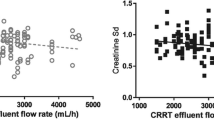Abstract
Acutely ill intensive care unit (ICU) patients often have large apparent volumes of distribution of drugs and, because of this, their drug clearance (CL) is usually also increased. ‘Augmented renal Cl’ is a current issue in the management of drug therapy for acutely ill and unstable ICU patients; however, Cl, the product of volume and the rate constant for excretion, describes only a theoretical volume of drug cleared per unit of time. Information of the actual rate of movement of the drug itself is obscured. It is suggested that the most useful clinical information is given by describing drug volume and elimination rate constant separately. This also permits better understanding of the patient’s separate issues of fluid balance and drug elimination, especially when dialysis, renal replacement therapy, or extracorporeal membrane oxygenation (ECMO) may be used, and facilitates management of these two important separate clinical issues. Optimal management of drug therapy also requires optimal methods embodied in clinical software to describe drug behavior in these highly unstable patients, and considerably more data than for ordinary patients. The interacting multiple model (IMM) clinical software facilitates management of both fluid balance and drug therapy in these unstable patients. Illustrative cases are discussed, and new monitoring and management strategies are suggested. Like other ICU skills, physicians need to learn optimal tools for managing drug therapy in the ICU. Further work should help evaluate these new approaches.






Similar content being viewed by others
References
D’Argenio D. Optimal sampling times for pharmacokinetic experiments. J Pharmacokinet Biopharm. 1981;9:739–56.
Jelliffe R, Bayard D, Neely M. Optimal sampling times weighted for the task to be optimized—control of AUC, peak, trough, etc. Presented at the PODE Conference; 11 Sep 2014, Basel. Abstract and slides available on Google by searching for “pode 2014”.
Bustad A, Terziivanov D, Leary R, Port R, Schumitzky A, Jelliffe R. Parametric and nonparametric population methods: their comparative performance in analysing a clinical data set and two Monte Carlo simulation studies. Clin Pharmacokinet. 2006;45:365–83.
Jelliffe R, Bayard D, Milman M, Van Guilder M, Schumitzky A. Achieving target goals most precisely using nonparametric compartmental models and “multiple model” design of dosage regimens. Ther Drug Monit. 2000;22:346–53.
Bayard D, Jelliffe R. A Bayesian approach to tracking patients having changing pharmacokinetic parameters. J Pharmacokinet Pharmacodyn. 2004;31:75–107.
Macdonald I, Staatz C, Jelliffe R, Thomson A. Evaluation and comparison of simple multiple model, richer data multiple model, and sequential interacting multiple model (IMM) Bayesian analyses of gentamicin and vancomycin data collected from patients undergoing cardiothoracic surgery. Ther Drug Monit. 2008;30:67–74.
Mehvar R. Teachers topics. The relationship among pharmacokinetic parameters: effects of altered kinetics on the drug plasma concentration–time profiles. Am J Pharmaceut Educ. 2004;68(2):article 36.
Jelliffe RW, D’Argenio DZ, Schumitzky A, Hu L, Liu M. The USC PC-PACK programs for planning, monitoring, and adjusting drug dosage regimens. Presented at the American Association of Medical Instrumentation annual meeting; 14–18 May 1988, Washington, D.C.
Niemiec P, Allo M, Miller C. Effect of altered volume of distribution on aminoglycoside levels in patients in surgical intensive care. Arch Surg. 1987;122:207–12.
Haug MT III, Slugg PH. Antibiotic pharmacokinetics. In: Sivak E, Higgins T, Seiver A, editors. The high risk patient: management of the critically ill. Media (PA): Williams & Wilkins; 1995. p. 1338–64.
Jelliffe R, Schumitzky A, Bayard D, Van Guilder M, Botnen A, Neely M, et al. The USC Pmetrics and Bestdose software—the only software with integrated population modeling, simulation, and maximally precise dosage. Laboratory of Applied Pharmacokinetics, USC Keck School of Medicine, Los Angeles, CA, USA. A software demonstration at the Population Approach Group Europe, Glasgow, Scotland; 11–14 June 2013. http://www.lapk.org.
Blom H. An efficient filter for abruptly changing systems. Proceedings of the 23rd Conference on Decision and Control; December 1984, Las Vegas (NV). p. 656–658.
Blom H, Bar-Shalom Y. The interacting multiple model algorithm for systems with Markovian switching coefficients. IEEE Trans Autom Control. 1988;33:780–3.
Mazor E, Averbuch A, Bar-Shalom Y, Dayan J. Interacting multiple model methods in target tracking: a survey. IEEE Trans Aerosp Electron Syst. 1998;34:103–23.
Jelliffe R. Optimal methodology is important for optimal pharmacokinetic studies, therapeutic drug monitoring, and patient care [commentary]. Clin Pharmacokinet. 2015;54(9):887–92.
Jelliffe R. Estimation of creatinine clearance in patients with unstable renal function, without a urine specimen. Am J Nephrol. 2002;22:320–4.
Cotta M, Roberts J, Lipman J. Antibiotic dose optimization in critically ill patients. Med Intensiva. 2015;39(9):563–72.
Acknowledgments
Many thanks to Dr. Alona Kryshchenko for her help with the figures.
Author information
Authors and Affiliations
Corresponding author
Ethics declarations
Funding
This work was supported in part by National Institutes of Health grants GM068968 and HD070886.
Conflicts of interest
Roger Jelliffe has no conflicts of interest to disclose.
Rights and permissions
About this article
Cite this article
Jelliffe, R. Challenges in Individualizing Drug Dosage for Intensive Care Unit Patients: Is Augmented Renal Clearance What We Really Want to Know? Some Suggested Management Approaches and Clinical Software Tools. Clin Pharmacokinet 55, 897–905 (2016). https://doi.org/10.1007/s40262-016-0369-4
Published:
Issue Date:
DOI: https://doi.org/10.1007/s40262-016-0369-4




